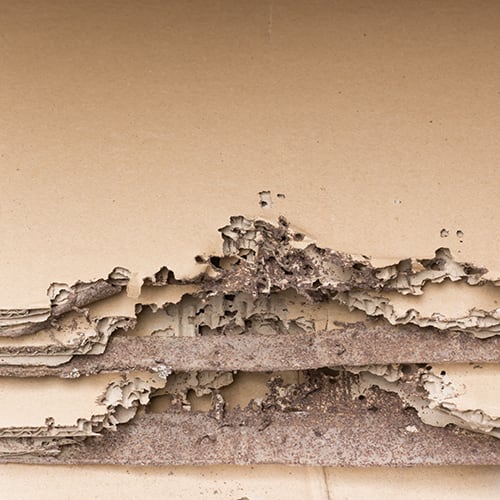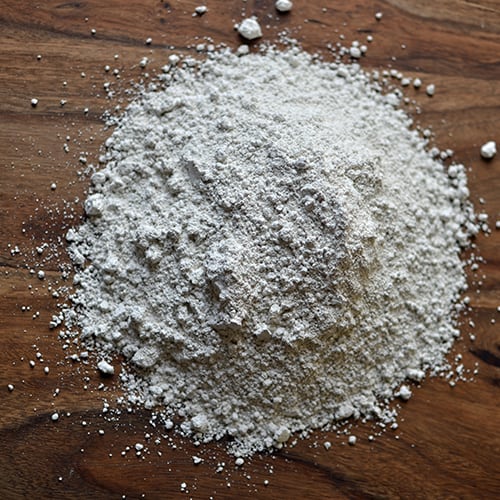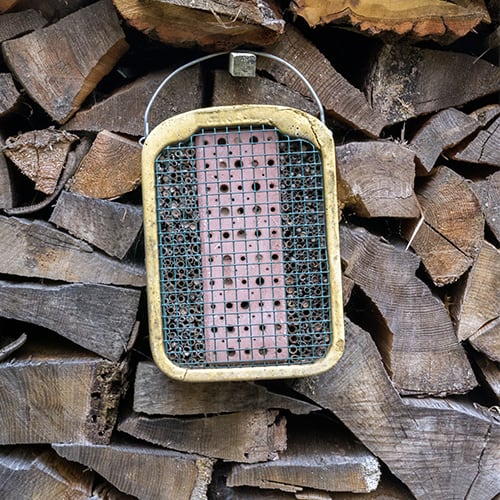TOUGHEST ON TERMITES

Termites Can Cause Significant Damage to Your Home

Luckily, most termites take years to damage a house beyond repair. Formosan Termites can damage an entire house within 2 years, though they tend to stick to coastal areas and the southern US.
In this part of the world, if you address termite problems quickly, you can save yourself thousands of dollars in repairs. If you're lucky - and vigilant, you will catch them while the repair costs are cosmetic rather than structural.
Unfortunately, not enough homeowners are vigilant with termite detection and extermination. In the United States, termites cause more damage to homes than fires, hurricanes, earthquakes, hail storms and wind.... combined.
Early detection of termites is vital to reduce the extent and cost of the damage.
How to Tell If You Have Termites
Termites often go undetected long enough to result in significant damage. There are three prevalent types of termites in North America, but the most common in New Jersey and nearby Pennsylvania are Eastern subterranean termites.
A termite colony will form a new infestation after an established colony produces mature adults with wings. This is called a swarm, and a swarm of termites is often a sign that a) a new infestation has come to your home or b) an infestation has been there for a few years now and is ready to spread.
How Can You Tell The Difference Between a Swarm of Flying Ants and Swarm of Termites?

- The front two wings on a termite are as long as the back two wings on a termite.
- An ant's front wings are significantly longer than their back wings.
- Termites have antennae that are almost completely straight.
- An ant's antennae are elbowed.
- Termite wings are twice as long as their body.
- Ant wings are shorter and more proportionate to their body.
- Termites have a wider waist and appear to be the same thickness across the length of their body.
- Ants appear very segmented with a smaller waist.
If you don't notice the swarm, but do come across a pile of discarded wings, that's a good sign that you have a termite infestation. The males discard their wings shortly after mating.

Other Signs of a Termite Infestation
Presence of "White Ants"
- Termites look white and almost translucent. It's important to remember that there is no such thing as a white ant. If you are seing white ants, then you have a termite infestation.
Moisture Warping of Doors/Windows
- As termites tunnel through the wood in your doors and windows, they can create moisture that may expand with the weather, causing your doors and windows to swell and stick as you try to open or close them.
Tunneling in Wood
- Often, you won't get to see the tunneling on the inside of the wood. Termites can be rather sneaky about their presence. However, if the surface of the wood breaks off and reveals tunneling inside, then you may have an active infestation. It is possible that the tunneling is left over from a previous infestation handled by a previous owner, however, it would be wise to have Victoria's Pest Control in to perform a thorough termite inspection.
Presence of Frass (Termite Droppings)
- Drywood termites leave frass in piles near small holes at the entrances to their nests. Most termites in this area are subterranean termites, which use their droppings to build their tunnels, however drywood termites are not rare either. If you see small black marks and what looks like dark wood dust, this may be termite frass. Knock on the wood around these areas. You may notice it has a hollow sound.
Mud-tubes on Your Foundation
- Subterranean termites are the most common type of termite in our area, and mud-tubes or termite tunnels are a sure sign of a termite infestation. There are four types of mud tubes that are used by subterranean termites: exploratory, working, swarming castle and drop tubes. Mud tubes can run over just about any surface you can think of. They make it easier for the termites to travel from food source to food source. Drop tubes extend from the ceiling and look like stalactites. Any sign of mud tubes is a good reason to call in Victoria's Pest Control for a thorough inspection.

Sags or discoloration in drywall
Peeling paint where there is no water damage
Crumbling, damaged wood
Buckling or wood/laminate floor boards or loosened tiles
Small holes in drywood
Maze-like patterns in wood furniture or other wood surfaces
Termite Infestation Prevention
Remembering first that subterranean termites are the most common type of termite infestation in our area, it is essential that you reduce or eliminate soil-to-wood contact around your house.
Lumber, plants, mulch, paper, cardboard... none of these items should be stored near the foundation of your home. Firewood should be as far from your home as you can manage without making it innaccessible during a storm.
Your siding should always start at least 6 inches above the soil line, and mulch should never reach closer than 4 inches from your foundation. (Consider a gravel/pebble/river stone line around your home to prevent gardeners/yard workers from thinking it's a good idea to expand the mulch past that line.)
Minimizing the amount of moisture and water around your foundation is not only vital for the safety of your foundation in general, but it can also reduce the attraction of termites to your home. Get a drainage expert to ensure that your foundation has proper grading, that your gutters empty out far enough away, and that french drains are installed wherever necessary to further carry water away from your home. The investment is well worth it.
Leaky faucets and other moist areas in the home can be an attraction to termites as well. Aside from the costs of water damage, excess water attracts a variety of pests. It's best to address these problems right away.
Reduce outdoor lighting during swarming season. After the winter thaw in early spring, termite swarms will be attracted to lights much like moths are. If you can mount your outdoor lighting on poles away from the wood construction of your home, it wouldn't be the worst idea. Especially if you have a log home, wood shingle siding, or a natural wood deck.
GET RID OF TERMITES

Termite Identification
While most termites in our area are subterranean, there are 3 common termites in the US. Each variety will require a slightly different approach.
- Subterranean Termites
- Drywood Termites
- Dampwood Termites
Termite Extermination: The Process
First, let us note that there are a number of DIY "solutions" on the internet. On our site, and in our business, we are always trying to educate our customers on the best ways to prevent pests and handle them without unnecessary professional help. However, we cannot in good conscience suggest any form of Do-It-Yourself Termite Removal. The financial risk to you and structural risk to your property is far too high.
Effective termite removal requires an intimate knowledge of the functioning of termite hives - from their construction, to an understanding of their hierarchical society.
Termite Sprays
Liquid and/or foam applications are a preventative measure that is especially effective with subterranean termites. These sprays kill termites on contact. This is not a solution for a termite infestation in and of itself, though applying this to other as-yet unaffected structures on your property is a good idea if you are battling a current infestation. Please note that these sprays should always be handled by a professional.

Termite Bait Systems
Termite bait systems are often used when a moderate termite presence has been found in the home. We strategically place bait systems around your property in a targeted effort to lure workers. They bring "food" back to their colonies which contains a killing agent.
The Dangers of "Termite Tenting" (Fumigation)
Termite tenting is an extremely dangerous practice for both the residents of the home and the technicians performing the proceedure. The sulfuryl fluoride used during termite fumigation is a central nervous system depressant, and is highly toxic to humans, animals and plants. There is no room for mistake. While the chemicals dissipate quickly, they leave a long-term effect on the immediate environment. As a green-house gas, these chemicals are 4000x more effective at trapping heat than CO2.
Termite Soil Injections
These liquid termiticides are the modern solution to termite treatment. This is the most common system of termite erradication because it both significantly reduces the population of termites while providing long-term protection to the area. A trench may be dug around the foundation in order to inject the termiticide where the termites nest. Even those in the house will return to their nests, making this an effective termite treatment strategy. Wood injections are also possible when/where necessary.
Additional Termite Strategies
Depending on your particular situation, we may employ some less common solutions including:
- Barrier Erection Outside of the Home
- Microwave Treatments
- Infrared cameras for termite detection.



